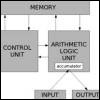
Session Overview
 |
This lecture covers course expectations, introduces computer programming and its uses, and begins to familiarize you with concepts related to how programs work. |
Session Activities
Lecture Videos
- Lecture 1: Introduction to 6.00 (00:41:28)
About this Video
Topics covered: Purposes of the course, declarative and imperative knowledge, flow of control, algorithms, fixed program and stored program computers, termination conditions, interpretation, compilation, syntax, static semantics, semantics, and types of errors.
Resources
Check Yourself
What is the difference between declarative and imperative knowledge?
› View/hide answer
Declarative knowledge is statements of fact; imperative knowledge is "how to" knowledge.
What is the advantage of a stored-program computer?
› View/hide answer
It's far more versatile than a fixed-program computer, since it interprets a program given to it and carries out those instructions, as opposed to being built to do one thing.
What are the syntax, static semantics, and semantics of a language?
› View/hide answer
Syntax determines whether a string is legal, static semantics determine whether the string has meaning, and semantics assigns a meaning to a legal sentence (assuming no static semantic errors).
What sorts of errors can occur in a program?
› View/hide answer
It can crash, run forever, or give a wrong answer.
Problem Sets
Problem Set 0 (Assigned)
Problem set 0 is assigned in this session. This is an ungraded problem set. The instructions can be found on the session page where it is due, Lecture 2 Core Elements of a Program.
Further Study
These optional resources are provided for students that wish to explore this topic more fully.
Readings
After watching the lecture, you may want to view some of the following resources:
